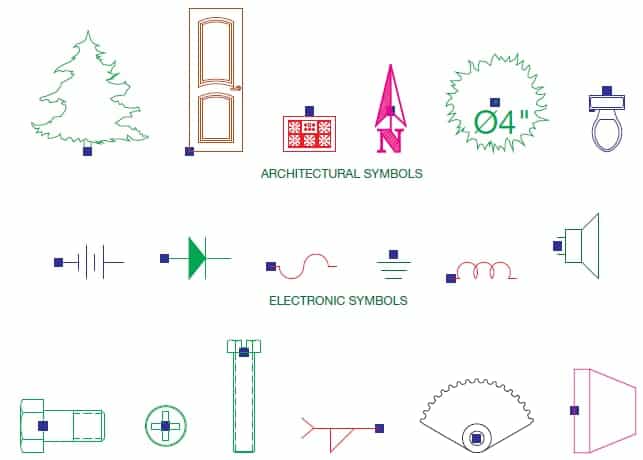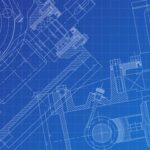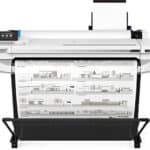How do you reuse elements in a 2D CAD design?

File templates, described later in this chapter, are another way to reuse drawing content. Customized templates provide an effective way to start each new file using standard settings. Another method to reuse drawing content is to seek out data from existing files. This is a common requirement when developing related drawings for a specific project or working on similar projects. Sharing drawing content is also common when revising drawings and when duplicating standards used by a consultant, vendor, or client. Most CADD programs provide several other options that automate the process of sharing drawing content, including reusing pre-drawn symbols and entire drawings. Specific CADD applications throughout this textbook provide additional information about reusing content with CADD.
CADD Symbols
A major benefit of drawing with CADD is the ability to create and store symbols in a drawing for future use. Saved reusable symbols are known by names such as symbols, blocks, cells, and reference files, depending on the CADD software. You can insert symbols as often as needed and share symbols between drawings. You also often have the option to scale, rotate, and adjust symbols to meet specific drawing requirements. Using symbols saves time when creating drawings and increases productivity.
Draw the elements of a symbol as you would any other geometry. A symbol can usually consist of any object or group of objects, including annotation, or it can be an entire drawing. Review each drawing and project to identify items you can use more than once. Screws, punches, subassemblies, plumbing fixtures, and appliances are examples of items to consider converting to reusable symbols. The process of converting objects to symbols varies with each CADD software. The common requirements are to select the objects to define as the symbol, specify an insertion base point that determines where the symbol is positioned during insertion, and save the symbol using a unique descriptive name. The figure shows some common drafting symbols. Once you create a symbol, the symbol is ready to insert in the current file or be added to other files as needed. As you define symbols, prepare a symbols library in which each symbol is available for reference. A symbol library is a collection of symbols that can be used on any drawing.
File Referencing
CADD software usually provides additional ways to reuse content, such as a system for referencing existing files. For example, AutoCAD provides an external reference, or Xref, the system to automate and manage file referencing. File-referencing tools provide an effective way to use and relate existing base drawings, complex symbols, images, and details to other drawings. File referencing also helps multiple users share content. Whether you have the option to reference a variety of files depends on the CADD software. For example, AutoCAD allows you to reference a drawing (DWG), design web format (DWF and DWFx) raster image, digital negative (DNG), or portable document format (PDF) file. Referencing a file is similar to inserting an entire drawing or a portion of a drawing as a symbol. However, unlike a symbol, which is usually stored in the file in which you insert the symbol, reference file information does not add to the host drawing. File data appears on-screen for reference only. The result is useful information but with a much smaller host file size than if you inserted a symbol or copied and pasted objects. Another benefit of file referencing is the link between reference and host files. If you make any changes to reference files, update the host drawings to display the most recent reference content. This allows you or a design drafting team to work on a multi-file project with the assurance that any revisions to reference files display in host drawings.
CAD content and symbols
Draftings Australia provides excellent 3d printing, 3d modelling services at an affordable rate. Call Us now!
What is 2D CAD design?
2D CAD design refers to the creation of two-dimensional digital drawings or blueprints using Computer-Aided Design (CAD) software. In 2D CAD design, objects, components, and structures are represented using two-dimensional geometric shapes, lines, and symbols, typically arranged on a flat plane.
Key characteristics of 2D CAD design include:
Geometric Shapes: 2D CAD software allows designers to create and manipulate basic geometric shapes such as lines, circles, rectangles, and polygons. These shapes serve as building blocks for creating more complex drawings and designs.
Drawing Tools: 2D CAD software provides a variety of drawing tools and features for creating and editing shapes, lines, and curves. These tools include drawing tools for creating precise lines and shapes, editing tools for modifying and adjusting geometry, and annotation tools for adding text, dimensions, and symbols to drawings.
Layering: 2D CAD software often includes layering functionality, allowing designers to organize and manage different elements of a drawing on separate layers. Layering enables designers to control visibility, editing, and formatting of specific components or groups of objects within a drawing.
Dimensioning: Dimensioning tools in 2D CAD software allow designers to add accurate dimensions, measurements, and annotations to drawings. Dimensioning is essential for conveying the size, scale, and geometry of objects and components in technical drawings.
Symbol Libraries: 2D CAD software often includes libraries of standard symbols, blocks, and components that can be easily inserted into drawings. These symbols represent commonly used objects, components, and annotations, such as electrical symbols, architectural symbols, and mechanical components.
Orthographic Projection: 2D CAD drawings typically use orthographic projection techniques to represent objects and structures from multiple views, such as top, front, side, and isometric views. Orthographic projection allows designers to depict the shape, size, and features of objects accurately in technical drawings.
Why is 2D design used?
2D CAD design refers to the creation of two-dimensional digital drawings or blueprints using Computer-Aided Design (CAD) software. In 2D CAD design, objects, components, and structures are represented using two-dimensional geometric shapes, lines, and symbols, typically arranged on a flat plane.
Key characteristics of 2D CAD design include:
Geometric Shapes: 2D CAD software allows designers to create and manipulate basic geometric shapes such as lines, circles, rectangles, and polygons. These shapes serve as building blocks for creating more complex drawings and designs.
Drawing Tools: 2D CAD software provides a variety of drawing tools and features for creating and editing shapes, lines, and curves. These tools include drawing tools for creating precise lines and shapes, editing tools for modifying and adjusting geometry, and annotation tools for adding text, dimensions, and symbols to drawings.
Layering: 2D CAD software often includes layering functionality, allowing designers to organize and manage different elements of a drawing on separate layers. Layering enables designers to control visibility, editing, and formatting of specific components or groups of objects within a drawing.
Dimensioning: Dimensioning tools in 2D CAD software allow designers to add accurate dimensions, measurements, and annotations to drawings. Dimensioning is essential for conveying the size, scale, and geometry of objects and components in technical drawings.
Symbol Libraries: 2D CAD software often includes libraries of standard symbols, blocks, and components that can be easily inserted into drawings. These symbols represent commonly used objects, components, and annotations, such as electrical symbols, architectural symbols, and mechanical components.
Orthographic Projection: 2D CAD drawings typically use orthographic projection techniques to represent objects and structures from multiple views, such as top, front, side, and isometric views. Orthographic projection allows designers to depict the shape, size, and features of objects accurately in technical drawings.
2D CAD design is widely used in various industries and applications, including architecture, engineering, construction, manufacturing, and interior design, for creating detailed drawings, schematics, blueprints, and technical documentation. While 2D CAD design is suitable for representing objects and components in two dimensions, it may be supplemented or replaced by 3D CAD design for more complex designs and visualizations.


